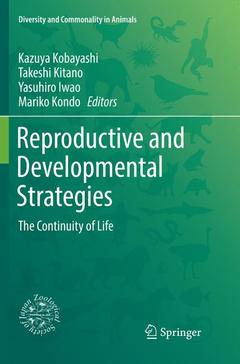Description
Reproductive and Developmental Strategies, Softcover reprint of the original 1st ed. 2018
The Continuity of Life
Diversity and Commonality in Animals Series
Coordinators: Kobayashi Kazuya, Kitano Takeshi, Iwao Yasuhiro, Kondo Mariko
Language: English
Subjects for Reproductive and Developmental Strategies:
Publication date: 01-2019
Support: Print on demand
Publication date: 06-2018
Support: Print on demand
Description
/li>Contents
/li>Biography
/li>Comment
/li>
This book provides new insights into the universality of biological systems in animal reproduction and development by a comparative study of a variety of mechanisms in animals ranging from basal invertebrates to vertebrates, including mammals.
Animals accomplish genetic diversity through meiosis and fertilization, and during embryogenesis animals must produce specialized cell types, including germ cells, in accordance with their individual body plan. This series of phenomena is essential to the continuity of life in the animal kingdom, and animals show various reproductive and developmental strategies.
This volume, comprising four parts, reviews animal kingdom diversity, including reproductive strategies and germ cell differentiation mechanisms (Part 1), sex determination and differentiation (Part2), the mechanisms of fertilization (Part 3), and body axis formation (Part 4). Readers will find descriptions of the reproduction or development of 180 species, 13 phyla, 35 classes, 74 orders, 117 families, and 151 genera in this book. Of particular interest is the diversity of molecules and mechanisms used to achieve the same biological purpose in different animals.
Undergraduates, graduate students, and professional scientists who want a deeper understanding of animal reproductive and developmental mechanisms will find this book to be of great value.
Preface.- Acknowledgments.- Part 1 Diversity in Reproductive Strategies and Germ Cell Differentiation Mechanisms.- Chapter1. Germ cell formation in solitary ascidians: coexistence of preformation and epigenesis.- Chapter2. Regulatory mechanisms of the germline stem cell niche in Drosophila melanogaster.- Chapter3. Regulation of germline stem cells in the teleost– gametogenesis, sex and fecundity –.- Chapter4. Regulatory mechanism of spermatogenic stem cells in mice: their dynamic and context-dependent behavior.- Chapter5. Nutritional control of the germline development in Caenorhabditis elegans.- Chapter6. Seasonal regulation of reproduction in vertebrates: Special focus on avian strategy.- Chapter7. Roles of germline stem cells and somatic multipotent stem cells in Hydra sexual reproduction.- Chapter8. Reproductive strategies in marine hydrozoan jellyfish: sexual medusae and asexual polyps.- Chapter9. Reproductive strategies in planarians: Insights gained from the bioassay system for sexual induction in asexual Dugesia ryukyuensis worms.- Chapter10. Reproductive strategies in Annelida: germ cell formation and regeneration.- Chapter11. Reproductive strategies in social amoeba.- Part 2 Diversity in the Sex Determination and Differentiation.- Chapter12. Environmental control on sex differentiation in Daphnia.- Chapter13. Sex determination cascade in insects: a great treasure house of alternative splicing.- Chapter14. Genetic control on sex determination and differentiation in fish.- Chapter15. Endocrine and environmental control of sex differentiation in gonochoristic fish.- Chapter16. Variety of sex change in tropical fish.- Chapter17. Sex determination and differentiation in frogs.- Chapter18. Environmental control on sex determination and differentiation in reptiles.- Chapter19. Sex determination and differentiation in birds.- Chapter20. Sex determination and differentiation in mammals.- Part 3 Diversity in the Mechanism of Fertilization.- Chapter21. Modulation of sperm motility and function prior to fertilization.- Chapter22. Postcopulatory reproductive strategies in spermatozoa.- Chapter23. Ascidian sexual reproductive strategies: Mechanisms of sperm-egg interaction and self-sterility.- Chapter24. Universality and diversity of a fast, electrical block to polyspermy during animal fertilization.- Chapter25. Preparing for fertilization: Intercellular signals for oocyte maturation.- Chapter26. Regulation of sperm-egg fusion at the plasma membrane.- Chapter27. Fertilization and Protein-tyrosine Kinase Signaling: Are They Merging or Emerging?.- Part 4 Diversity in Axis Formation.- Chapter28. Early embryonic Axis Formation in a Simple Chordate Ascidian.- Chapter29. Recent advances in hagfish developmental biology in a historical context: implications for understanding the evolution of the vertebral elements.- Chapter30. Left-right specification in the embryonic and larval development of amphibians.- Chapter31. The molecular basis of the gastrula organizer in amphibians and cnidarians.- Chapter32. Axis formation and its evolution in ray-finned fish.- Chapter33. Post-embryonic axis formation in planarians.- Chapter34. Larval and Adult Body Axes in Echinoderms.




